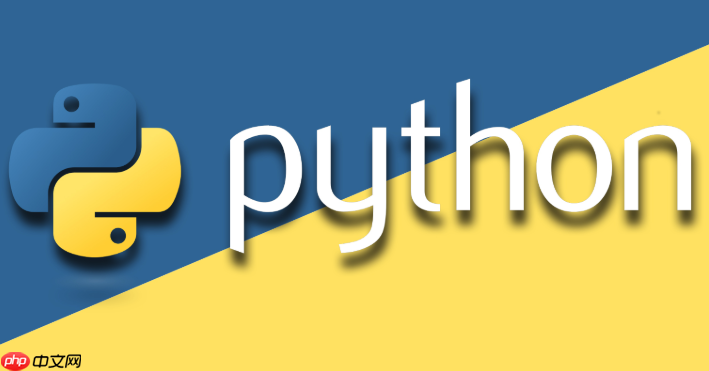在python中使用cryptography庫進行aes加密的步驟如下:1. 安裝cryptography庫;2. 生成密鑰并安全存儲;3. 加載密鑰用于加密和解密;4. 實現數據加密與解密操作;5. 錯誤處理以應對密鑰錯誤。此外,可根據需求選擇其他庫如pycryptodome,并結合rsa實現更安全的數據傳輸方案,同時需重視密鑰的安全管理。

python實現數據加密,核心在于選擇合適的加密庫和算法。常見的有cryptography庫,以及諸如AES、RSA等加密算法。選擇哪個,取決于你的安全需求、性能考量以及數據類型。

Python提供了多種庫來實現數據加密,但選擇合適的加密算法至關重要。

如何在Python中使用cryptography庫進行AES加密?
cryptography庫是Python中一個強大的加密庫,支持多種加密算法。AES(Advanced Encryption Standard)是一種常用的對稱加密算法,速度快且安全性高。以下是如何使用cryptography庫進行AES加密的步驟:
立即學習“Python免費學習筆記(深入)”;
-
安裝cryptography庫:

pip install cryptography
-
生成密鑰:
AES加密需要一個密鑰。密鑰長度可以是128位、192位或256位。更長的密鑰通常更安全,但也更耗費計算資源。
import os from cryptography.fernet import Fernet def generate_key(): """生成一個AES密鑰.""" key = Fernet.generate_key() with open("secret.key", "wb") as key_file: key_file.write(key) # 首次運行生成密鑰 # generate_key()注意:密鑰需要安全地存儲,否則加密的數據就形同虛設。
-
加載密鑰:
def load_key(): """從文件中加載密鑰.""" with open("secret.key", "rb") as key_file: return key_file.read() key = load_key() -
加密數據:
from cryptography.fernet import Fernet def encrypt_message(message: bytes, key: bytes) -> bytes: """使用AES加密消息.""" f = Fernet(key) encrypted_message = f.encrypt(message) return encrypted_message message = b"This is a secret message." encrypted = encrypt_message(message, key) print(f"Encrypted message: {encrypted}") -
解密數據:
def decrypt_message(encrypted_message: bytes, key: bytes) -> bytes: """使用AES解密消息.""" f = Fernet(key) decrypted_message = f.decrypt(encrypted_message) return decrypted_message decrypted = decrypt_message(encrypted, key) print(f"Decrypted message: {decrypted}")錯誤處理:如果密鑰不正確,解密會失敗,拋出異常。你需要捕獲cryptography.fernet.InvalidToken異常。
RSA和AES,該如何選擇?
RSA是非對稱加密算法,而AES是對稱加密算法。這意味著RSA使用公鑰和私鑰,而AES使用單個密鑰。
- 安全性: RSA在密鑰管理方面更安全,因為私鑰不需要在網絡上傳輸。但AES在計算效率上更高,適合加密大量數據。
- 速度: AES比RSA快得多。對于需要快速加密/解密大量數據的場景,AES是更好的選擇。
- 使用場景: RSA通常用于密鑰交換、數字簽名等場景。AES通常用于加密存儲在磁盤上的數據或在網絡上傳輸的數據。
通常,我們會結合使用RSA和AES:使用RSA加密AES密鑰,然后使用AES加密實際數據。這既保證了密鑰的安全傳輸,又保證了數據加密的速度。
除了cryptography庫,還有其他選擇嗎?
當然,Python還有其他的加密庫,比如PyCryptodome。PyCryptodome是PyCrypto的替代品,修復了PyCrypto的一些安全漏洞,并且提供了更多的加密算法。
pip install pycryptodome
使用PyCryptodome進行AES加密的示例:
from Crypto.Cipher import AES from Crypto.Random import get_random_bytes import hashlib def encrypt_message_pycrypto(message: bytes, password: str) -> bytes: """使用PyCryptodome進行AES加密.""" # 創建一個密鑰 salt = get_random_bytes(AES.block_size) private_key = hashlib.scrypt( password.encode(), salt=salt, n=2**14, r=8, p=1, dklen=32) cipher_config = AES.new(private_key, AES.MODE_GCM) # 加密消息 cipher_text, tag = cipher_config.encrypt_and_digest(bytes(message)) return { 'cipher_text': cipher_text, 'salt': salt, 'nonce': cipher_config.nonce, 'tag': tag } def decrypt_message_pycrypto(enc_dict, password): """使用PyCryptodome進行AES解密.""" salt = enc_dict['salt'] cipher_text = enc_dict['cipher_text'] nonce = enc_dict['nonce'] tag = enc_dict['tag'] private_key = hashlib.scrypt( password.encode(), salt=salt, n=2**14, r=8, p=1, dklen=32) cipher = AES.new(private_key, AES.MODE_GCM, nonce=nonce) decrypted = cipher.decrypt_and_verify(cipher_text, tag) return decrypted password = "P@$$wOrd" message = b"This is a secret message from PyCryptodome." encrypted = encrypt_message_pycrypto(message, password) decrypted = decrypt_message_pycrypto(encrypted, password) print(f"Decrypted message: {decrypted}")
選擇哪個庫取決于你的具體需求和偏好。cryptography庫更加現代化,而PyCryptodome提供了更多的算法選擇。
如何安全地存儲密鑰?
這是加密中最關鍵的部分。如果密鑰泄露,所有的加密都將失效。
- 硬件安全模塊 (HSM): HSM是一種專門用于安全存儲密鑰的硬件設備。
- 密鑰管理系統 (KMS): KMS是一種軟件系統,用于安全地存儲、管理和使用密鑰。
- 使用環境變量: 將密鑰存儲在環境變量中,而不是硬編碼在代碼中。
- 加密密鑰: 使用一個主密鑰加密其他密鑰。主密鑰需要非常安全地存儲。
記住,加密不僅僅是選擇一個好的算法,更重要的是如何安全地管理密鑰。一個弱密鑰管理方案會使最強大的加密算法也變得毫無意義。



















